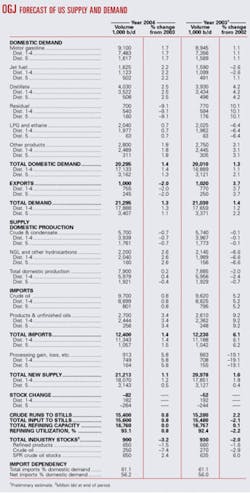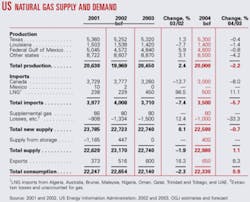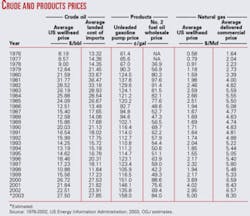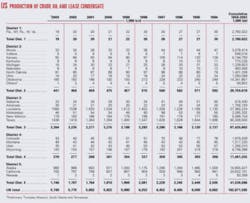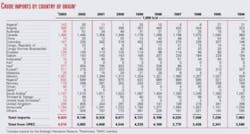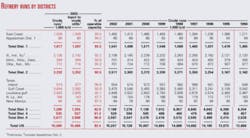Continued economic growth in 2004 will drive energy demand in the US. Consumption of all sources of energy, including oil, natural gas, and coal, will increase, boosting total demand to its highest level ever.
Demand for all petroleum products, excluding residual fuel oil, will grow on the strength of the economy. US production of crude oil and condensate will continue to slide, while natural gas liquids production rebounds to give total US liquids a small boost over last year's output.
Imports will be up, but by a much smaller margin than last year, and inventories will remain tight. This will mean that prices of oil and gas have little chance to post sizable declines.
Gas production in the US will decline, as will imports of gas from Canada and Mexico, but LNG imports will continue to grow.
US economy
Economic recovery will continue this year, increasing energy consumption for the third year in a row. OGJ forecasts that US GDP will increase 4% this year and that the use of energy will realize efficiency gains.
The US economy grew last year at unexpected rates, and the energy market became more efficient. Real gross domestic product—the output of goods and services produced by labor and property located in the US—increased at an annual rate of 8.2% in the third quarter of 2003. In the second quarter, real GDP increased 3.1%, following a first quarter gain of 2%.
The rush in real GDP growth in the third quarter primarily reflected acceleration in personal consumption expenditures, deceleration in imports, an upturn in exports, and accelerations in residential fixed investment and in equipment and software. These positives were partly offset by a downturn in federal national defense spending, according to the Bureau of Economic Analysis.
Low interest rates are helping to fuel economic growth. At its June 25, 2003, meeting the Federal Open Market Committee lowered the federal funds rate by 25 basis points to 1%, where the rate has remained since.
Industrial production rose 0.9% in November, its largest increase since October 1999, the Federal Reserve Board reported. At 113% of its 1997 average, output was 1.6% above its level in November 2002. Capacity utilization for total industry moved up 0.6 percentage points, to 75.7%, a level 0.3 percentage point higher than its year-earlier level but 5.6 percentage points below its 1972-2002 average.
The Bureau of Labor Statistics of the US Department of Labor reported that productivity, as measured by output per hour of all persons, for the third quarter of 2003, grew at the seasonally adjusted annual rates of 8.6% in the business sector and 9.4% in the nonfarm business sector.
Total energy consumption
OGJ projects that the US economy will consume 1.2% more energy this year than last and be more efficient.
During 2003, the US consumed 97.84 quadrillion btu (quads) of energy, up just 0.2% from the previous year. Energy efficiency improved 4.1%, however, as the US consumed 9.3 btu/ $1 of real GDP.
US energy efficiency will improve to 9.04 btu/$1 of real GDP this year. Energy efficiency has improved or been static every year since 1970, meaning that the amount of energy consumed per dollar of GDP has not increased despite a steady rise in energy consumption.
Energy by source
US demand for all sources of energy will increase this year. No one category of energy will see a large boost in consumption, but rather each will get a small increase in use.
Increased consumption of distillate, jet fuel, and motor gasoline will boost demand for crude oil 1.4% this year. The US will use a total of 39.45 quads of oil in 2004, and oil will comprise 39.8% of the energy market. US oil demand increased 1.3% last year.
Gas demand will grow nearly 1%, following a decline last year. In 2003, gas demand fell 2.3% under the weight of high prices and a drop in industrial and electric power demand.
Together, oil and gas will account for 62.9% of the US energy market, the same as last year. In 2002, oil and gas comprised 63% of the market.
In 1972, the use of oil and gas peaked, providing 77.7% of energy to the US market.
Demand growth for coal will slow to 0.9% following a 1.5% increase last year. The US this year will consume 55.7 quads of coal, which will account for 22.9% of all energy used.
Used increasingly for electric power generation and less for the industrial sector, coal consumption has been on the rise since 1976 when total demand was 13.6 quads.
OGJ expects the use of nuclear energy to climb this year to 8.15 quads. Nuclear energy use changed very little over the past 2 years, constrained by capacity limitations. The US has been operating 104 nuclear units since 1998. Nuclear accounts for 8.2% of the energy market.
Aided by heavy precipitation in the Northwest, the use of hydroelectric power will boost consumption of the remaining category of all other energy sources. Energy use from hydro and other renewable sources will climb 1.2% this year to 5.9 quads. These sources, which include solar, wind, and geothermal, will comprise 6% of all energy used in the US this year.
Oil supply
US crude and condensate production will decline again this year, to average 5.7 million b/d. In 2003, output slipped to 5.74 million b/d from 5.746 million b/d.
Depletion rates have overcome robust drilling rates, strong oil prices, and sustained capital spending in the past couple of years to slowly erode US production.
The Baker Hughes Inc. count of active rotary drilling rigs operating in the US last year averaged 1,032, up from the 2002 average of 830. The number of rigs operating in the Gulf of Mexico declined, though, to 104 from 109 the year before and 148 in 2001.
Early estimates indicate a decline in Alaskan production last year, and total US production has declined each year since 1991. In 2002, Alaskan production reversed its decline trend and inched up to average 984,000 b/d from 963,000 b/d the year before.
OGJ estimates that production of crude and condensate last year increased moderately in Texas to 1.436 million b/d from 1.418 million b/d a year earlier and in Louisiana to 1.56 million b/d from 1.538 million b/d.
Estimates also indicate a decline in California's average production to 765,000 b/d from 797,000 b/d. In Oklahoma, crude and condensate output declined to an estimated average of 180,000 b/d from 183,000 b/d the year before.
Production of NGL will increase this year as the price of gas moderates a bit. High gas prices last year made it less economical to extract the liquids, as was the case in January 2001, when NGL production averaged just 1.4 million b/d.
The 2003 decline in NGL output was not nearly as severe, as the lowest monthly average was 1.53 million b/d for May. For all of 2003, production of NGL and other liquid hydrocarbons averaged an estimated 2.1 million b/d.
This year, hydrocarbons production of NGL and other liquids will average 2.2 million b/d. Total US liquids production will average 7.9 million b/d, an increase of only 0.2% from last year.
Inventories
Total industry stocks of crude and products stood at 930 million bbl at the end of 2003, down from 949 million bbl a year earlier.
In its Weekly Petroleum Status Report for the week ended Jan. 2, EIA reported that at 269 million bbl, US crude oil inventories were 27.8 million bbl less than the 5-year average for that time of year and 1 million bbl below what the agency terms "the lower operational inventory level."
At the end of 2002, crude oil inventories, excluding crude in the Strategic Petroleum Reserve (SPR), were 278 million bbl, and product stocks were 671 million bbl. At the end of last year, product stocks were an estimated 660 million bbl.
Total motor gasoline inventories finished 2003 at 1.4% lower than a year earlier. Jet fuel stocks ended 2.8% below their year-earlier level, but stocks of distillate and residual fuel oil were more plentiful than a year earlier. Stocks of resid gained 24%, and distillate inventories were up 1.6% from yearend 2002.
OGJ forecasts that crude and product stocks will decline again this year. Product stocks are expected to fall 1.5% while crude stocks finish 2004 at 250 million bbl. OGJ expects SPR stocks to reach 650 million bbl at the end of this year.
SPR stocks built last year to 635 million bbl from 599 million bbl at the end of the year, as the effort to fill the SPR to its 700 million bbl capacity by as early as next year continued. No oil was imported to supply the SPR last year as opposed to 2002, when the US imported on average 16,000 b/d for the reserve.
Imports
Increasing demand will require the US to import more crude oil and products this year.
Total US industry imports, excluding any for the SPR, will rise to an average 12.4 million b/d from 12.23 million b/d last year. This compares with total imports of 11.53 million b/d in 2002.
Crude oil imports will move up to 9.7 million b/d from 9.62 million b/d, and product imports will climb to 2.7 million b/d from 2.61 million b/d last year. The largest exporter of crude oil to the US last year was Saudi Arabia; such has been the case each year since 1998. The US imported an average of 1.75 million b/d of crude from Saudi Arabia last year.
The second largest source of crude imports last year was Mexico with 1.56 million b/d. Following Mexico were Canada, Venezuela, Nigeria, and the UK.
Canada remained the source of the most US petroleum product imports last year. Following Canada as the leading sources of product imports were Algeria, the US Virgin Islands, Vene- zuela, Norway, and the Netherlands.
Refining, prices
Refiners operated at relatively high levels last year. With operable throughput capacity at US refineries of 16.76 million b/d, utilization averaged more than 92%.
Total capacity expanded very little last year, up from 16.74 million b/d in 2002, and will be static this year, the first year in many in which capacity creep will not be a factor.
Last year, crude oil runs were up 2.2% to 15.28 million b/d. OGJ expects refinery inputs to increase nearly 1% this year, pushing capacity utilization to 93%.
Tight supplies and the war in Iraq kept prices of oil elevated throughout 2003. High crude prices held refining margins in check, although pump prices for gasoline were strong.
The estimated average price of US wellhead crude oil increased to $27.50/bbl, compared with $22.50/ bbl a year earlier. The average landed cost of imported crude oil increased to an estimated $27.85/bbl from $23.82/ bbl. The composite refiner acquisition cost of crude oil averaged an estimated $28.75/bbl last year, up from $24.10/ bbl the prior year.
The pump price of gasoline last year averaged $1.58/gal vs. $1.36/gal in 2002. Heating oil prices gained last year, as well. The average wholesale price of No. 2 fuel oil climbed to an estimated 84¢/gal from 69.4¢/gal a year earlier.
US Gulf Coast cash refining margins averaged $3.23/bbl last year, according to Muse, Stancil & Co. The highest monthly average for the margin last year was February's, at $5.83/bbl. For 2002, the US Gulf Coast cash refining margin averaged $2.02/bbl.
Oil product demand
Oil product demand in the US will increase just a bit more this year than it did last year, as exports of products and crude decline following a 2003 increase. Demand for all oil products except resid will increase this year. The expanding economy will require more fuel for transportation, so consumption of motor gasoline, jet fuel, and distillate will grow.
OGJ forecasts that total US demand for oil products will increase 1.4% this year to 20.295 million b/d. This compares with a 1.3% increase last year. US exports of products and crude will average 1 million b/d, down from 1.02 million b/d last year but still above the 2002 average of 984,000 b/d.
Motor gasoline
Demand for motor gasoline will average 9.1 million b/d this year. Motor gasoline averaged 8.9 million b/d last year and 8.8 million b/d the year before that.
OGJ expects pump prices to subside a bit this year, and personal income will move up, adding to the effects of the stronger economy to boost gasoline demand.
Gasoline prices declined in the fourth quarter of last year after a gradual build earlier in the year took the average price in March—at the outset of the war in Iraq—to $1.71/gal. After falling a bit throughout the summer, the average price for September, the peak of driving season, climbed again to $1.74/gal. For November, the average pump price declined to $1.54/gal.
Jet fuel
Economic growth and fewer safety concerns will cause the first increase in jet fuel demand in 3 years. OGJ forecasts a 2.2% increase in jet fuel consumption this year vs. a 1.5% decline last year.
Last year jet fuel demand was tempered by the war in Iraq, bad weather in May and June, renewed terrorist attack warnings, and fewer flights. The Air Transport Association of America reported that through November 2003, US passenger traffic departures were down 7.3% from a year earlier but enplanements had declined only 2.6% from the same period a year earlier.
US production of jet fuel declined last year, but both imports and exports of the fuel increased. At an average 1.625 million b/d, consumption of jet fuel this year will approach its 2001 level of 1.655 million b/d. Jet fuel demand peaked in 2000, at 1.725 million b/d.
Distillate
This year, demand for distillate fuel oil will grow another 2.5% following a 4.2% increase last year. OGJ forecasts that in 2004, distillate demand will average 4.03 million b/d.
Distillate is used for heating and for transportation, especially trucking, rail, and marine commercial transport. Increased economic activity causes a boost in distillate consumption.
Since the fuel can be used as a substitute for gas, demand can get a boost when gas prices are high, as was the case last year.
The number of heating degree-days—a measure of how cold a location is over a period of time relative to a base temperature, most commonly specified as 65° F.—last year ran higher than during 2002.
Residual fuel oil
Resid demand will decline 9% this year to 700,000 b/d, following a 10% gain last year.
Consumption of resid spiked last summer due to warm weather in New England and the Mid-Atlantic states, where fuel-switching favored less-expensive resid over gas for electric power generation. Further, demand was propped up in December as gas prices stayed high and resid was used for heating.
While these short-term fuel substitutions give resid demand a boost, over the long term resid demand is waning in favor of gas.
Slightly lower prices for gas this year will be the primary reason for the drop in resid use.
Other petroleum products
Demand for all other petroleum products, which generally fluctuates with economic activity, will increase by a small margin this year.
OGJ expects that demand for liquid petroleum gas (LPG) and ethane, primarily used as petrochemical feedstocks, will grow less than 1%, though. Use of LPG and ethane in the US last year declined more than 6% from 2.16 million b/d in 2002. Decreased petrochemical production will keep demand for these products from reaching that level this year.
Demand for all other products, including asphalt and lube oils, will move up nearly 2%. Last year, this group realized a 3% jump in demand.
Natural gas
Total US gas consumption will increase slightly following a 2.3% decline last year.
OGJ forecasts that continued economic recovery will boost gas demand 0.9% this year. Some of the demand that was lost in the industrial and electric power sectors will return as prices ease somewhat.
Cold early 2003 winter weather could not overcome the weak economy to sustain gas demand. While gas use among residential and commercial consumers held up, consumption by industry and electric utilities declined last year under price pressures.
The amount of gas in storage was a concern in the tight US market last year. Abundant 2002 stocks were rapidly depleted during the first quarter of 2003. Inventories of working gas swung from the upper level of the 5-year average to the bottom.
At the end of March, working gas was 730 bcf, as reported by EIA. A gradual summer build left such stocks at 2.8 tcf at the end of September. For the week ended Jan. 2, working gas was still above the year-ago level at 2.57 tcf.
The price of oil, storage concerns, and reservoir depletion rates bolstered gas prices throughout the year in spite of depressed demand.
In 2003, the New York Mercantile Exchange near-month futures price of gas averaged $5.49/MMbtu compared with $3.37/MMbtu a year earlier. The average US wellhead price of gas increased in 2003 to an estimated $5/Mcf from $2.95/Mcf a year earlier.
The average number of gas-directed drilling rigs in the US in 2003 increased to 875 from 691 a year earlier, as reported by Baker Hughes. The 2001 count of gas-directed drilling rigs averaged 939.
OGJ forecasts that US gas production will decline a bit more than 2% this year to 20 tcf. Increased drilling and capital expenditures are fighting decline rates in the shallow waters of the Gulf of Mexico.
US gas production increased 2.4% last year, according to early estimates. While production from Louisiana declined nearly 8% and Texas production was up only 1.3%, output from the federal Gulf of Mexico areas increased almost 6%. The US will import less gas this year. OGJ forecasts a 6% decline in total imports, although LNG imports will continue to grow.
Total US gas imports declined last year despite a near doubling of LNG imports. During 2003, the US imported larger volumes of LNG than during the previous year from Algeria, Malay- sia, Nigeria, Oman, and Trinidad and Tobago. The US imported 229 bcf of LNG in 2002. LNG imports grew to an estimated 450 bcf last year as security concerns eased and additional receiving capacity became available.
Almost 14% less Canadian gas reached the US last year. Demand for gas in Mexico has absorbed all of the gas that was being exported from that country to the US. Imports of gas into Mexico were up an estimated 63 bcf from 2002.
US gas exports will continue to increase this year, but OGJ expects the growth rate of total US gas exports to slow this year to 8% following a 16% increase last year. The US exported 373 bcf of gas in 2001 and 516 bcf in 2002.


